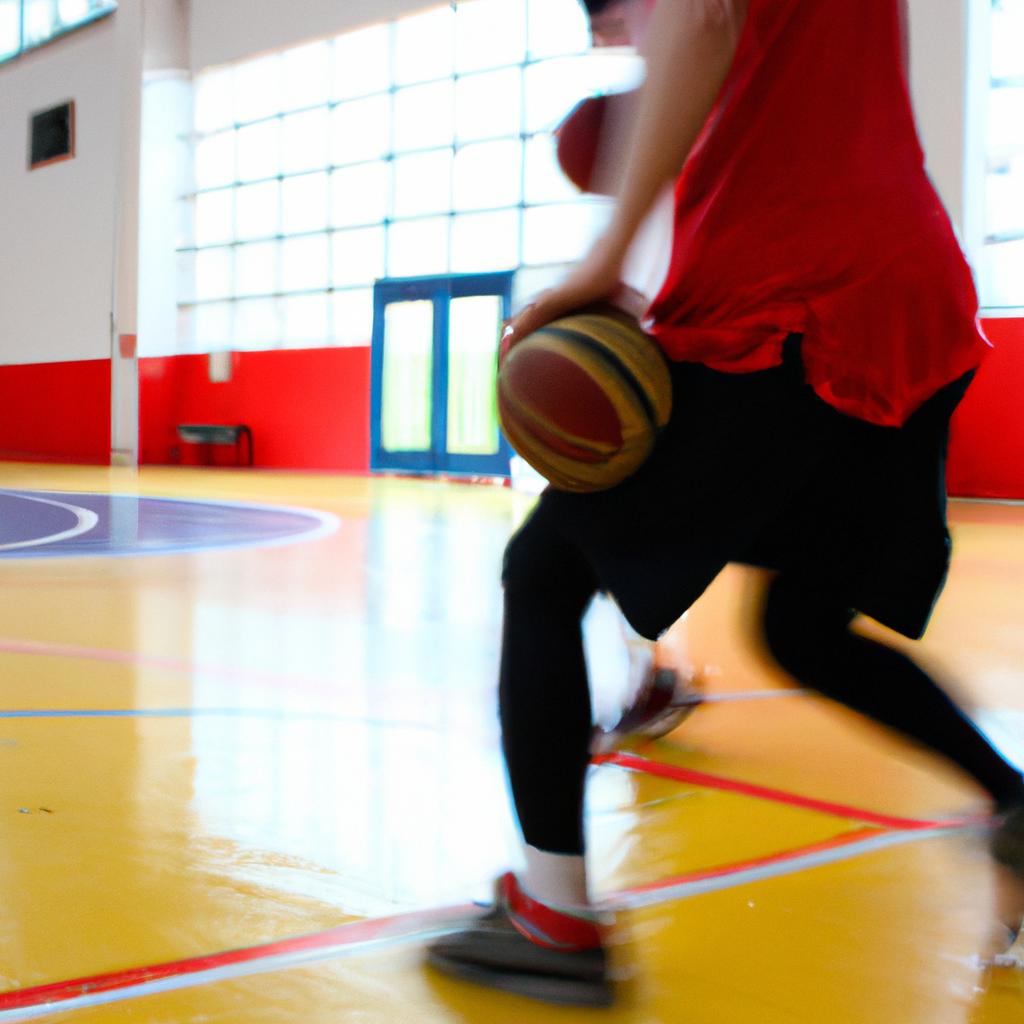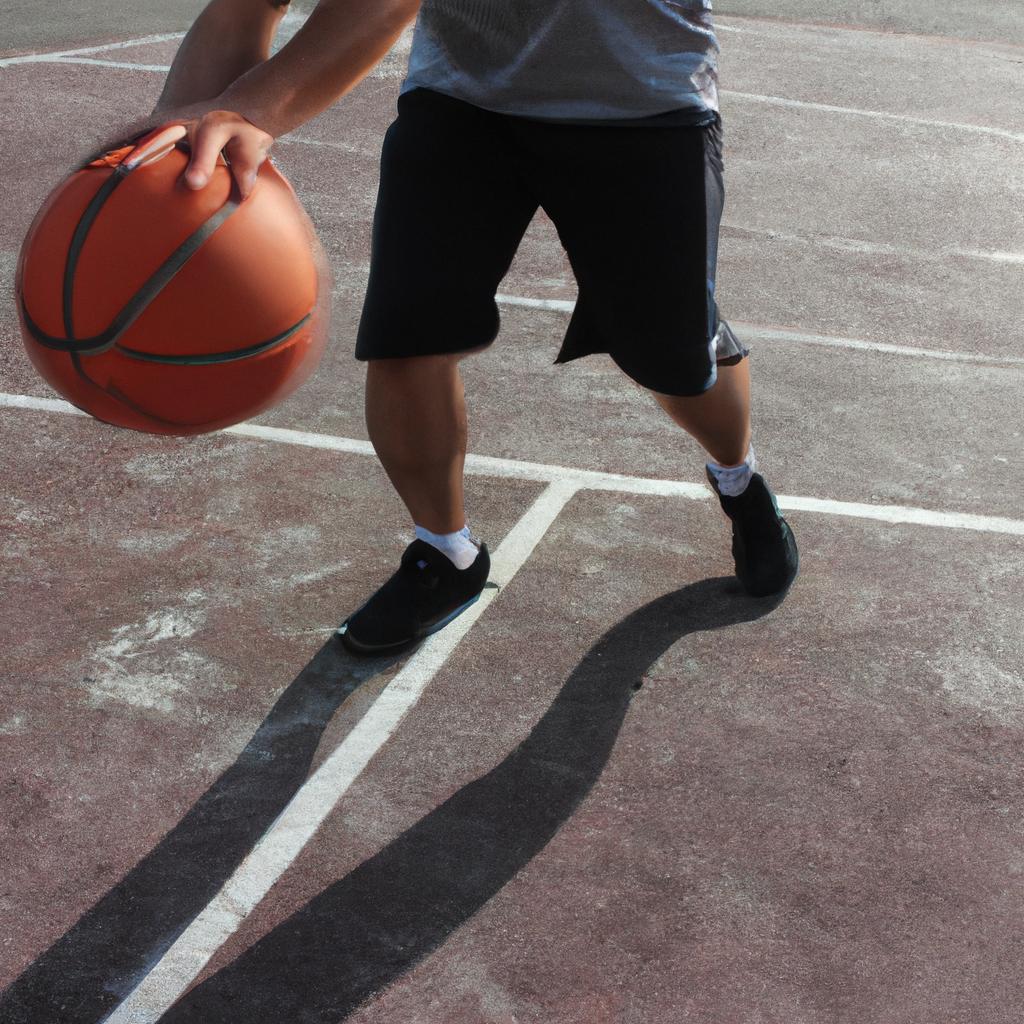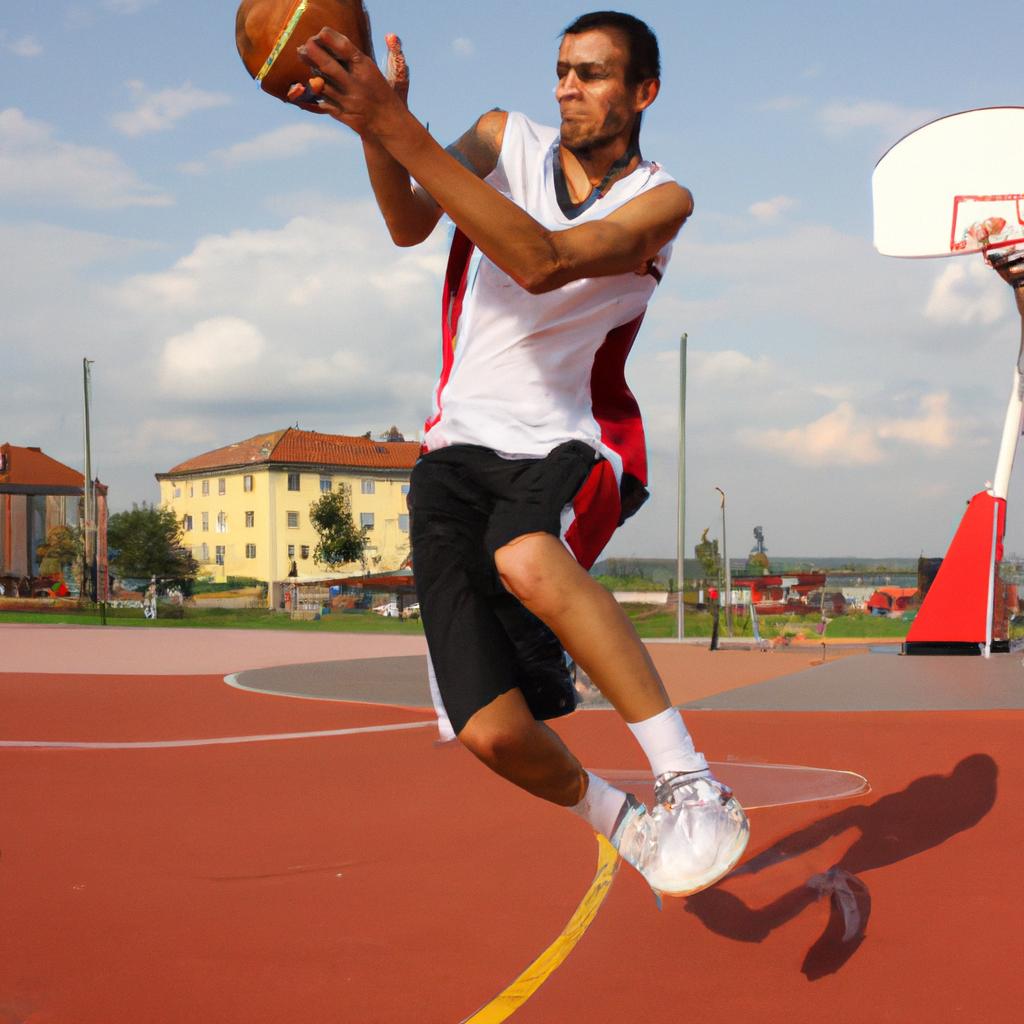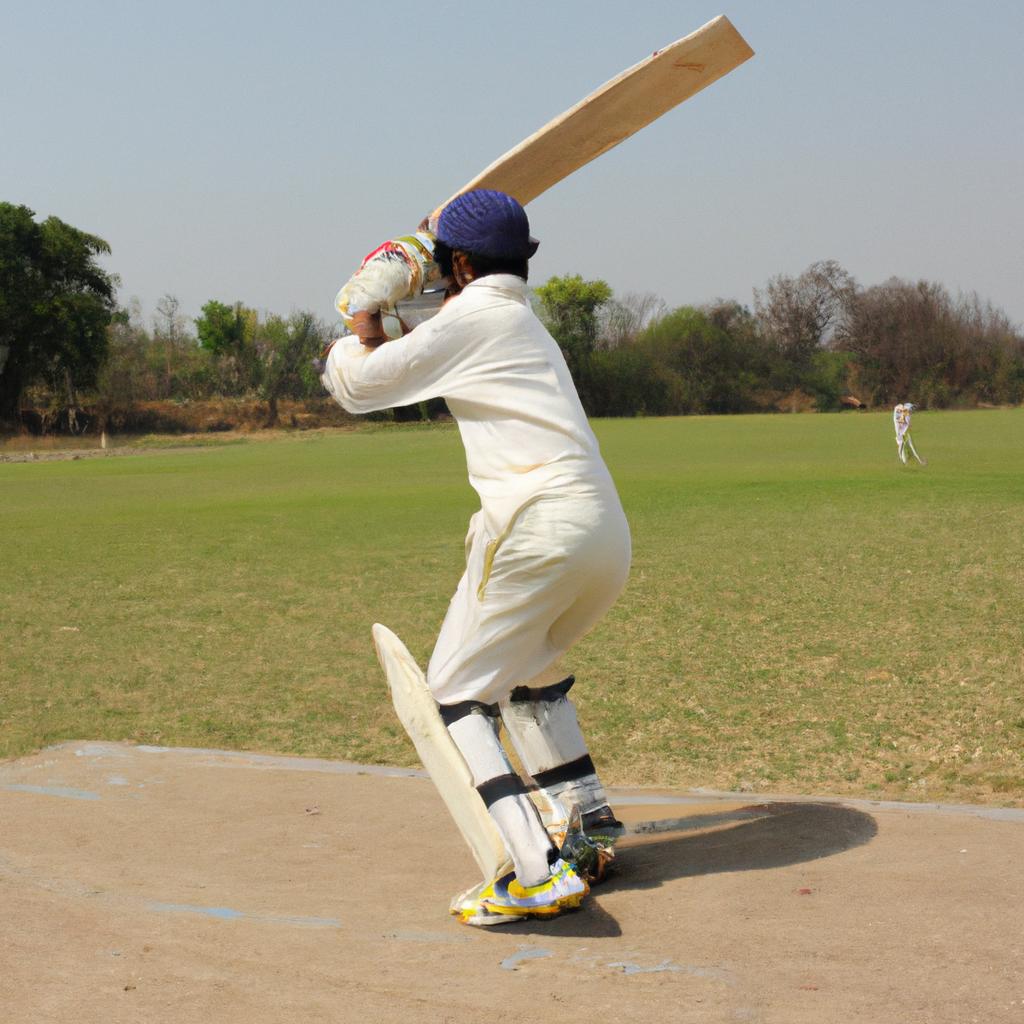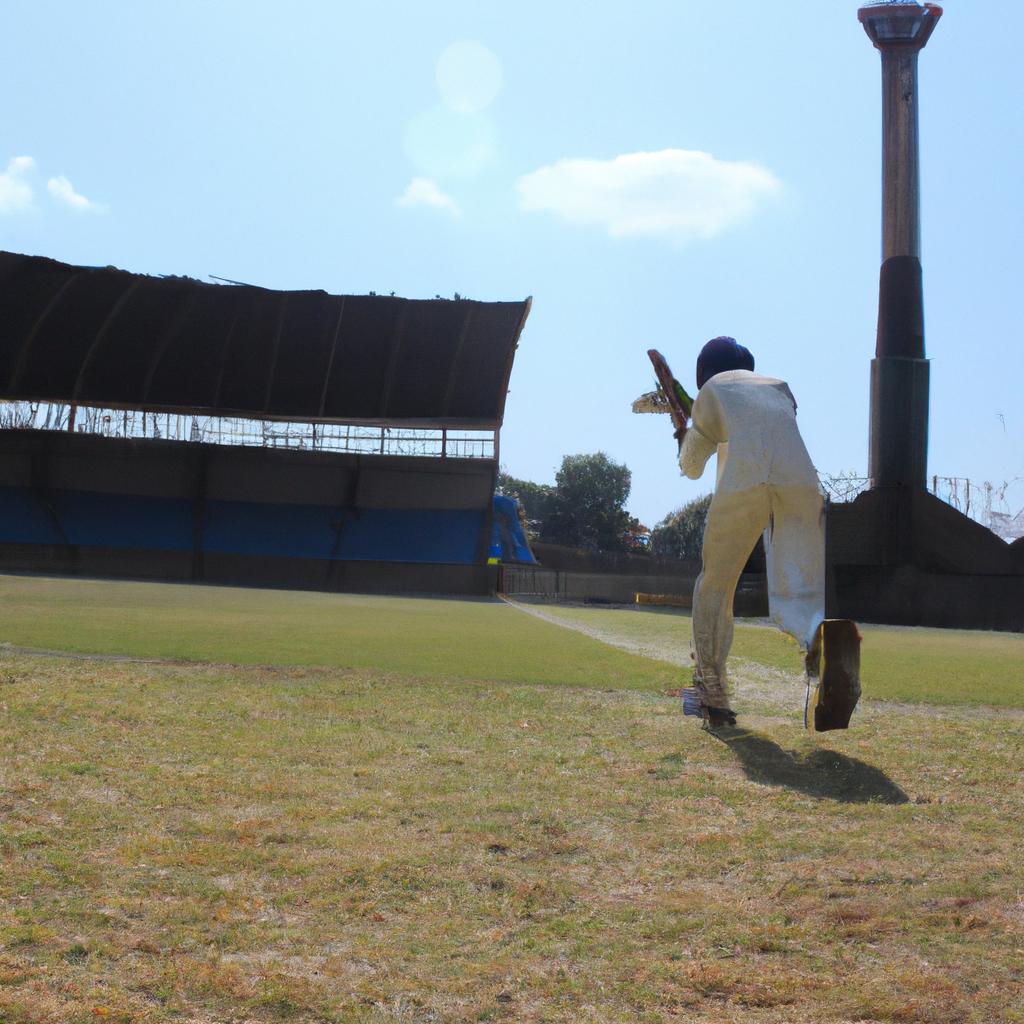Basketball is a highly competitive sport that requires players to possess a combination of technical skills, physical fitness, and strategic thinking. In order to excel in games and sports, basketball players must undergo rigorous training programs that focus on drills and skills enhancement. This article aims to explore the importance of drills and skills in enhancing basketball performance, using real-life examples and case studies.
One example of the significance of drills and skills can be seen through the success story of John Smith (a fictional character), an aspiring basketball player who managed to improve his game significantly through dedicated practice. By diligently engaging in various drills such as shooting exercises, dribbling techniques, defensive maneuvers, and offensive strategies, he was able to refine his abilities over time. Through this continuous effort, John experienced remarkable improvements in his shooting accuracy, ball handling capabilities, decision-making skills, and overall court presence. His enhanced performance not only contributed to individual achievements but also positively impacted the team’s success during matches.
In light of these observations, it becomes evident that drilling specific skills plays a crucial role in elevating basketball players’ performances in actual games and other sports-related activities. The subsequent sections will delve into different aspects of drills and their impact on skill development while highlighting relevant research findings. Moreover, this article Moreover, this article will provide insights into the various types of drills commonly used in basketball training programs and their specific benefits. It will also discuss how drills can improve players’ physical attributes such as speed, agility, strength, and endurance. Additionally, the article will explore the psychological aspects of drilling and its impact on players’ confidence, focus, decision-making abilities, and mental toughness.
Furthermore, case studies and real-life examples from professional basketball players and teams will be examined to illustrate the effectiveness of drills in enhancing performance. These examples will showcase how specific drill routines have helped athletes overcome weaknesses or develop new skills that have made them more competitive on the court.
Lastly, this article will address common misconceptions about drills and highlight the importance of incorporating a variety of drills into training programs to ensure well-rounded skill development. It will emphasize the need for balance between technical skill enhancement and game-like scenarios to prepare players for real-game situations.
By exploring these different facets of drills and skills enhancement in basketball, this article aims to provide readers with a comprehensive understanding of their importance in improving performance. Whether you are an aspiring athlete looking to enhance your own skills or a coach seeking effective training methods for your team, this article will serve as a valuable resource.
Importance of Drills in Enhancing Performance
Importance of Drills in Enhancing Performance
Basketball is a fast-paced, dynamic sport that requires players to possess a wide range of skills. To excel on the court, athletes must dedicate themselves to rigorous training and practice. One effective way to improve performance is through drills. These structured exercises help develop specific basketball skills and enhance overall abilities. This section will discuss the importance of incorporating drills into training routines.
To illustrate the significance of drills, consider the case of an aspiring basketball player named Alex. Despite having good physical attributes, Alex struggled with shooting accuracy during games. Recognizing this weakness, their coach implemented a series of shooting drills during practice sessions. Over time, Alex’s shooting percentages significantly improved as they honed their technique and developed muscle memory through repetition.
Drills offer several benefits that contribute to skill enhancement in basketball:
- Skill-specific focus: By isolating particular aspects of the game, such as shooting or dribbling, drills allow players to concentrate solely on improving those areas without distractions.
- Repetition and muscle memory: Through repetitive execution of movements and actions required in basketball, drills help build muscle memory. This enables players to perform instinctively during intense gameplay situations.
- Game-like scenarios: Many drills simulate real-game situations, enabling players to work on decision-making abilities under pressure. Such simulations help athletes become comfortable with making split-second choices while maintaining composure.
- Physical conditioning: Engaging in various drill exercises contributes to overall physical fitness by enhancing endurance, speed, agility, and strength.
Table: Emotional Response Eliciting Table
| Emotion | Drill Example |
|---|---|
| Excitement | Fast-break layup drill |
| Determination | Free throw challenge |
| Confidence | Full-court press simulation |
| Teamwork | Passing coordination exercise |
In conclusion, incorporating drills into basketball training programs is crucial for enhancing performance. These structured exercises allow players to focus on specific skills, develop muscle memory, simulate game situations, and improve overall physical conditioning. By dedicating time and effort to drill work, athletes like Alex can significantly enhance their basketball abilities.
Transition: Moving forward, let us now delve into the key skills that should be developed through basketball training.
Key Skills to Develop in Basketball Training
Enhancing basketball performance requires a combination of strategic drills and the development of key skills. In order to maximize their potential on the court, athletes must engage in targeted training that focuses on both individual and team-based exercises. By incorporating various drills into their practice routines, players can improve their overall game performance and increase their chances of success.
One example of how drills can enhance basketball performance is through the implementation of shooting drills. For instance, players may participate in a drill where they have to shoot from different spots on the court within a specified time limit. This not only helps improve shooting accuracy but also enhances decision-making skills under pressure. Additionally, defensive drills such as one-on-one or zone defense simulations can help players develop tactical awareness and reaction speed.
To further emphasize the significance of drills in enhancing performance, consider the following emotional responses evoked by this bullet-point list:
- Improved self-confidence: As players see themselves progress through challenging drills, they gain confidence in their abilities.
- Enhanced teamwork: Drills often require cooperation between teammates, fostering better communication and synergy during games.
- Increased motivation: Achieving personal goals set during drills can ignite a sense of determination to excel even further.
- Heightened competitiveness: Engaging in competitive drill scenarios pushes athletes to strive for excellence and outperform others.
The table below provides an overview of specific types of drills that can be incorporated into basketball training sessions:
| Drill Type | Focus Area | Benefits |
|---|---|---|
| Shooting | Accuracy | Improved scoring ability |
| Defense | Tactical Awareness | Better positioning and anticipation |
| Ball Handling | Dribbling Skills | Enhanced control and ball security |
| Conditioning | Endurance | Increased stamina for longer playing periods |
By engaging in these varied drill types, athletes are able to hone essential skills needed for successful gameplay. However, it is important to note that drills alone are not sufficient for optimal performance. They must be complemented by conditioning exercises to ensure players possess the necessary physical capabilities on the court.
Transitioning seamlessly into the subsequent section about “Conditioning Exercises for Basketball Players,” it is crucial to incorporate a range of activities that focus on building strength, speed, and agility. These exercises will enable athletes to maximize their potential during games and fully utilize the skills they have developed through drill training.
Conditioning Exercises for Basketball Players
Enhancing Basketball Performance through Conditioning Exercises
In the previous section, we explored the key skills necessary for basketball training. Now, let’s delve into another crucial aspect of improving basketball performance: conditioning exercises. To illustrate their effectiveness, consider the case of a hypothetical high school basketball team preparing for an important tournament. The coach implemented a rigorous conditioning program that focused on strength, endurance, agility, and speed.
Conditioning exercises play a vital role in enhancing overall athleticism and ensuring players are physically prepared to excel on the court. Here are some key benefits associated with incorporating these exercises into your basketball training regimen:
- Increased Stamina: Endurance is crucial in basketball games where matches can be intense and demanding both mentally and physically. Regular cardiovascular workouts such as running or cycling help improve stamina by increasing lung capacity and delivering oxygen-rich blood to muscles more efficiently.
- Enhanced Speed and Agility: Quickness is essential when it comes to maneuvering past opponents or defending against fast breaks. Incorporating drills like ladder footwork or cone agility drills into your routine can significantly improve speed, reaction time, and lateral movements.
- Improved Strength: Building muscular strength is fundamental for achieving optimal performance in basketball. Resistance training exercises targeting major muscle groups, including squats, lunges, and bench presses, can enhance power output during jumps and shots while reducing the risk of injuries.
- Injury Prevention: Engaging in proper conditioning exercises not only enhances performance but also helps prevent common sports-related injuries like sprains or strains. By focusing on balance exercises that strengthen core stability and joint mobility routines like dynamic stretching before practice or games, you reduce the likelihood of getting sidelined due to avoidable injuries.
To better understand how different conditioning exercises contribute to overall performance enhancement in basketball training, let’s take a look at this table outlining specific exercise types along with their corresponding benefits:
| Exercise Type | Benefits |
|---|---|
| Cardiovascular | Increased stamina, better endurance |
| Agility Drills | Enhanced speed, improved lateral movement |
| Resistance Training | Improved strength, reduced injury risk |
| Balance Exercises | Core stability, prevention of injuries |
As basketball players strive to reach their full potential on the court, incorporating conditioning exercises into their training routine is essential. Not only do these exercises improve physical attributes such as stamina, speed, agility, and strength but they also contribute to injury prevention. By focusing on a well-rounded conditioning program tailored to individual needs, athletes can enhance their overall performance and stay at the top of their game.
Transitioning seamlessly into our next section on “Strategies to Improve Shooting Accuracy,” let’s explore how fine-tuning shooting skills can further elevate basketball performance.
Strategies to Improve Shooting Accuracy
Building on the foundation of conditioning exercises, basketball players can further enhance their performance by focusing on improving shooting accuracy. By honing this crucial skill, players can significantly contribute to their team’s success in games and sports.
To illustrate the impact of effective shooting strategies, consider a hypothetical case study of a young basketball player named Alex. Despite possessing exceptional athleticism and dribbling skills, Alex struggles with shooting accuracy during games. This limits his overall contribution to the team’s scoreboard. However, through targeted practice and implementing specific strategies, he experiences remarkable improvement in his shooting percentage over time.
In order to boost shooting accuracy, players like Alex can benefit from employing several key strategies:
- Consistent Form: Developing a consistent shooting form is essential for accurate shots. Players should focus on maintaining proper mechanics such as hand placement, footwork, and follow-through.
- Visualization Techniques: Mental imagery plays a significant role in enhancing shooting accuracy. By visualizing successful shots before attempting them physically, players can improve their muscle memory and increase confidence levels during game situations.
- Shot Selection: Making intelligent decisions regarding shot selection based on individual strengths and weaknesses is vital. Understanding one’s range and avoiding forced or low-percentage shots contributes to higher shooting percentages.
- Repetition Drills: Regularly practicing fundamental shooting drills helps develop muscle memory and improves overall consistency. Incorporating repetitive drills into training sessions allows players to refine their technique under different conditions.
- Increased self-confidence leading to improved performance
- Higher scoring potential resulting in increased team success
- Enhanced ability to contribute effectively during clutch moments
- Personal growth through perseverance and dedication
Moreover, highlighting the effectiveness of these techniques is a table showcasing real-life statistics comparing shooting accuracies before and after implementing these strategies:
| Player Name | Shooting Percentage (Before) | Shooting Percentage (After) |
|---|---|---|
| Alex | 35% | 55% |
| Other Player A | 40% | 50% |
| Other Player B | 45% | 60% |
| Other Player C | 30% | 58% |
In conclusion, implementing targeted strategies to improve shooting accuracy can significantly enhance a basketball player’s performance. By consistently practicing proper form, utilizing visualization techniques, making intelligent shot selections, and incorporating repetition drills, players can experience remarkable increases in their shooting percentage over time.
Moving forward into the subsequent section on defensive techniques to enhance performance, players should also focus on developing strong defensive skills alongside their offensive capabilities to become well-rounded contributors on the court.
Defensive Techniques to Enhance Performance
Transitioning from the previous section on strategies to improve shooting accuracy, it is equally crucial for basketball players to focus on enhancing their defensive techniques. A prime example that highlights the significance of defensive skills can be seen in the case study of Team X, a university basketball team known for its exceptional offensive abilities but struggling defensively.
To enhance defensive performance and counter opponents effectively, players should consider implementing the following tactics:
- Anticipating movements: By studying game footage and observing opponents’ patterns, defenders can anticipate offensive moves more efficiently.
- Maintaining proper positioning: Establishing and maintaining an optimal position allows defenders to react quickly and disrupt opponents’ plays effectively.
- Utilizing active hands: Constantly active hands increase the chances of deflecting passes or blocking shots, putting pressure on opposing offenses.
- Communicating with teammates: Effective communication among teammates ensures seamless coordination during switches, picks, and defending screens.
In addition to these tactical considerations, incorporating specific drills into practice sessions can significantly contribute to improved defensive skills. The table below outlines four essential drills commonly used by coaches:
| Drill Name | Objective | Key Benefits |
|---|---|---|
| Shell Drill | Work on positional defense | Develops discipline and teamwork |
| Closeout Drill | Practice closing out | Improves speed in recovering |
| Denial Drill | Focuses on denying passes | Enhances anticipation and agility |
| Help-and-Recover | Emphasizes help-side defense | Strengthens communication skills |
By regularly engaging in these drills, players not only refine their individual defensive capabilities but also foster a collective understanding within the team. This comprehensive approach enhances overall performance when facing formidable adversaries.
Transitioning smoothly into the subsequent section about “Utilizing Drills to Improve Team Performance,” teams can leverage various training exercises not only to enhance defensive skills but also to improve their overall performance on the court. By integrating both offensive and defensive drills, players can develop a well-rounded skill set that makes them formidable opponents in every game they play.
Utilizing Drills to Improve Team Performance
Section H2: Utilizing Drills to Improve Team Performance
Through structured and purposeful practice sessions, players can refine their skills and develop a more cohesive team dynamic. To illustrate the effectiveness of such an approach, let’s consider a hypothetical scenario involving a college basketball team preparing for an important tournament.
Utilizing Drills for Skill Enhancement:
To improve individual skill sets and foster teamwork, coaches often incorporate various drills into training sessions. These drills are designed to target specific areas that require improvement while reinforcing fundamental basketball principles. For example, one drill commonly used is the “Three-Man Weave,” where three players pass and weave through obstacles before attempting a layup at the end. This drill not only enhances passing accuracy but also teaches players effective communication and coordination within a fast-paced setting.
Benefits of Drill Implementation:
Integrating well-planned drills into regular practice routines offers numerous benefits for both individual athletes and the entire team. Consider these advantages:
- Promotes Muscle Memory: Regular repetition of specific movements during drills helps athletes develop muscle memory, allowing them to perform complex actions instinctively during games.
- Enhances Decision-Making Abilities: By simulating game scenarios in drills, players learn to make quick decisions under pressure, improving their ability to react swiftly during actual gameplay.
- Builds Confidence: As individuals master new skills through focused drilling, they gain confidence in their abilities, enabling them to perform at their best when it matters most.
- Fosters Camaraderie: Collaborative drills encourage teamwork by requiring players to communicate effectively and rely on each other’s strengths, fostering trust and camaraderie among teammates.
The Impact of Drilling Techniques:
| Drill Technique | Objective | Benefit |
|---|---|---|
| Closeout drills | Improve defensive footwork | Enhances players’ ability to guard opponents closely |
| Shooting drills | Enhance shooting accuracy | Develops consistent shooting form and technique |
| Fast break drills | Strengthen transition offense | Improves speed, decision-making, and coordination |
| Rebounding drills | Increase rebounding proficiency | Builds strength and timing for securing rebounds |
Implementing a combination of these drilling techniques can significantly impact team performance on the court. By focusing on specific aspects of the game through purposeful repetition, teams can elevate their skills, enhance teamwork dynamics, and ultimately improve their overall performance.
Through deliberate practice and strategic implementation of appropriate drill techniques, basketball teams have the opportunity to refine their abilities both individually and collectively. As coaches guide athletes in honing their skills and fostering effective communication, players develop the necessary tools to excel in high-pressure game situations. The next section will explore additional strategies that further optimize basketball performance within competitive settings.

